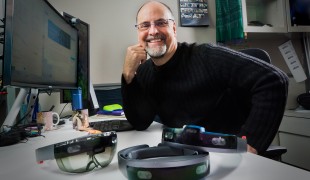- 9316
- 666
- 5
- 19
- 0
- Help Ukraine
About the solution
Andrew uses a computer software program to communicate with his family and friends. The program scans through a variety of words, pictures and letters, and Andrew must operate a switch with his head to indicate the words he wants to say. But because of a movement disorder that accompanies his rare form of the disease, he often hits the switch unintentionally and his messages become garbled. What Gary did was create a light-activated switch that reduces the incidental contact with the switch.
With this device, a light-activated switch, Andrew is less likely to activate the computer program inadvertently. To use the new gadget, he wears a headband that has a light the size of a needlepoint, which he directs at a small receiver attached to the head support on his wheelchair. Because of the device’s small size, it’s harder for Andrew to activate the communication switch by accident and because the transmitter and receiver are close together, Andrew only needs to make slight deliberate movements to activate it.
“He’s been using the computer for learning how to read, spell and construct sentences, and he was getting a lot of false hits,” said Andrew’s father, Gary Sylvia. “He’s learning how to read and write and it’s important for him to have good software so he doesn’t get frustrated.”
Comtois created the new device as part of his internship to develop assistive technologies for patients at the Eleanor Slater Hospital in Cranston, and it took him two months to complete the project.
“I was thinking about it – this invention is actually going to do something for someone. Then it’s not work anymore – I’m going to help someone. The fact that behind this project was a real patient in need really motivated me. I came up with an initial design, then met with Andrew and his parents to learn more specifically what they needed, and then modified the design based on their input”, explained the inventor. A lot of the ideas for the final design came from Andrew’s father.
Gary Sylvia, then a URI chemical engineering graduate, is grateful that Comtois engineered a device that will improve Andrew’s ability to communicate and function, something that is essential to his development and schooling.
“Anything that can increase his efficiency and accuracy will add to his ability to interact with the computer,” Sylvia said. “The switch becomes more important depending on how far Andrew goes. As he proceeds (in school) he needs to be quicker and more accurate. The switch has great potential to go forward, and be designed for other children”.
Adapted from: http://bit.ly/2vFop2T
More info: http://bit.ly/2tzwYe4
This solution shall not include mention to the use of drugs, chemicals or biologicals (including food); invasive devices; offensive, commercial or inherently dangerous content. This solution was not medically validated. Proceed with caution! If you have any doubts, please consult with a health professional.
DISCLAIMER: This story was written by someone who is not the author of the solution, therefore please be advised that, although it was written with the utmost respect for the innovation and the innovator, there can be some incorrect statements. If you find any errors please contact the patient Innovation team via info@patient-innovation.com
-
-
363
-
0
-
4182

Using AI to allow blind people to find familiar faces
COMMUNICATION: Communicating, whether by speaking, listening, or other means
Social interaction
Blindness
5 Senses support devices: (glasses, hearing aids, headphones...)
Body-Worn solutions (Clothing, accessories, shoes, sensors...)
App (Including when connected with wearable)
AI algorithm
Assistive Daily Life Device (to help ADL)
Difficulty communicating with environment
Confusion
Regaining sensory function
Promoting self-management
Promoting inclusivity and social integration
Improving Speech and Communication
Raise awareness
Ophthalmology
Pediatrics
United States
-
-
-
765
-
0
-
17099

Proloquo2Go – App to help people communicate
CAREGIVING
COMMUNICATION: Communicating, whether by speaking, listening, or other means
Social interaction
Paralysis
Autism
Cerebral Palsy
Brain Stroke
Brain Injury (Abscess, Brain Barrier Defect, Brain Contusion, Brain Hemorrhage, Brain Edema)
Assistive Daily Life Device (to help ADL)
Assistive Technology access
App (Including when connected with wearable)
Tremors
Muscle cramps or spasms
Difficulty coordinating movements
Muscle weakness
Difficulty speaking or understanding speech
Trouble with fine motor skills (e.g., writing, buttoning clothes)
Twitching or involuntary movements (myoclonus)
Acquired language impairment (Aphasia)
Promoting self-management
Managing Neurological Disorders
Building Supportive Community Relationships
Promoting inclusivity and social integration
Improving Speech and Communication
Caregiving Support
Clinical Pathology
Medical Genetics
Neurology
Pediatrics
Rheumatology
Netherlands
-
-
-
646
-
0
-
8476

Father invents iPhone app to aid his son to communicate
COMMUNICATION: Communicating, whether by speaking, listening, or other means
CAREGIVING
Pitt Hopkins Syndrome
App (Including when connected with wearable)
Building Supportive Community Relationships
Promoting inclusivity and social integration
Improving Speech and Communication
Caregiving Support
Child and Adolescent Psychiatry
General and Family Medicine
Neurology
Pediatrics
United States
-
 en
en